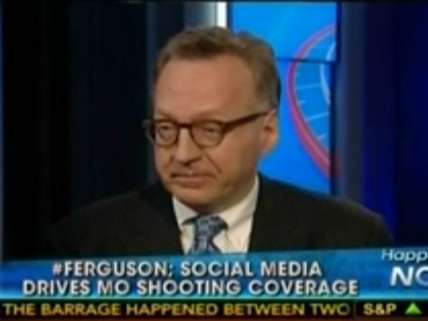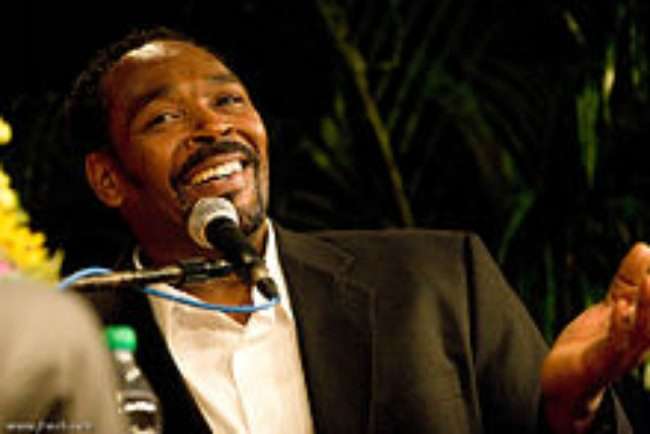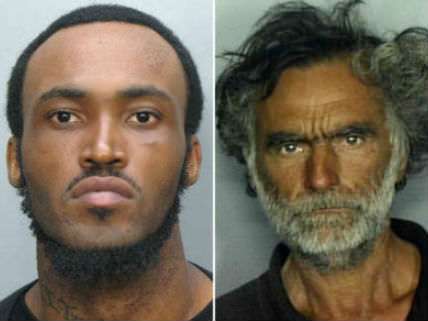PCP Hallucinations in Ferguson
Blaming drugs for Michael Brown's death revives an ugly stereotype.

Darren Wilson thought Michael Brown was "on something." Or so says one of Wilson's friends, describing the police officer's state of mind when he shot and killed the unarmed black teenager on August 9 in Ferguson, Missouri. "He really thinks he was on something, because he just kept coming," said the friend, identified only as "Josie," during a phone call to a St. Louis radio show last week. "It was unbelievable."
Earlier that same day, Fox News commentator Jim Pinkerton made a similar suggestion. "Eyewitnesses said that Brown was charging the cops," Pinkerton said on the channel's Happening Now show. "We'll know more with a blood test. If he was high on some drug, angel dust or PCP or something…it's entirely possible you could take a lot more than six bullets and keep charging." In other words, if Brown was high on PCP, firing just six rounds into him would be a mark of restraint.
A few hours later, The Washington Post reported that the blood test anticipated by Pinkerton showed "Brown had marijuana in his system when he was shot." The article, based on information from an unnamed source familiar with St. Louis County's investigation of the shooting, said nothing about PCP.
Unfazed by that news, R. Emmett Tyrrell Jr., editor in chief of The American Spectator, speculated in a column published two days later that PCP-laced marijuana caused the aggressive behavior described by Wilson. "Those Swisher Sweet cigars are used as a conduit for ingesting a mixture of PCP and marijuana," Tyrrell wrote, referring to the stolen cigarillos Brown was carrying. "My guess is that Brown's senseless death was brought on by…psychosis and permanent brain injury."
It should be emphasized that witnesses disagree about whether Brown was moving toward Wilson when he was shot, which is a central point of contention in the case, since it underpins Wilson's claim that he fired in self-defense. But either way, attempts to explain Brown's alleged actions by reference to psychoactive substances he might have consumed exaggerate the power of those chemicals, which may encourage the use of excessive force by stoking officers' fears of people whom they perceive to be "on something." This kind of fear mongering is also regrettable because it harks back to a shameful history of warnings about people with dark skin and drug-infused blood.
The invocation of PCP to explain what looks like excessive police force is familiar from the 1992 trial of the Los Angeles police officers who beat Rodney King. "I thought that the suspect was under the influence of PCP," Sgt. Stacey Koon testified. "In my mind, he had exhibited this Hulk-like strength which I had come to associate with PCP." Although King tested negative for PCP, Koon still thought his mistaken belief about the content of King's blood should count as a mitigating factor, since everyone knows that PCP turns people into irrationally violent monsters with superhuman strength.

As is often the case with illegal drugs, what everyone knows turns out to be wrong. In a1988 review of 350 journal articles on PCP in humans, the psychiatrist Martin Brecher and his colleagues concluded that "PCP does not live up to its reputation as a violence-inducing drug."
Brecher et al. noted that high doses of PCP can produce "severe agitation and hyperactivity," along with "cognitive disorganization, disorientation, hallucinations, and paranoia." Combined with the drug's anesthetic effect, which makes users less sensitive to pain and therefore harder to restrain, such acute reactions have contributed to PCP's fearsome image. Yet in their search of the literature, Brecher and his co-authors found only three documented cases in which people under the influence of PCP alone had committed acts of violence. They also noted that between 1959 and 1965, when PCP was tested as a human anesthetic, it was given to hundreds of patients, but "not a single case of violence was reported."
This does not mean PCP users are never violent. But when they are, their behavior cannot be understood as a straightforward effect of the drug. "Research on the nexus between substance use and aggression," notes the criminologist Jeffrey Fagan, "consistently has found a complex relation, mediated by the type of substance and its psychoactive effects, personality factors and the expected effects of substances, situational factors in the immediate settings where substances are used, and sociocultural factors that channel the arousal effects of substances into behaviors that may include aggression." The pharmacologist John P. Morgan and the sociologist Lynn Zimmer put it this way: "No drug directly causes violence simply through its pharmacological action."
This point is obvious when we consider alcohol, the drug that is most strongly associated with violence. The fact that some people get into fights after drinking does not mean alcohol makes them behave that way. Variations in responses to alcohol across individuals, cultures, and situations show that drinking does not necessarily lead to bloodshed.
To some extent, the ascription of malevolent powers to chemicals is an attempt to explain behavior that otherwise seems inexplicable. That is one reason so many news outlets credulously accepted the claim that synthetic stimulants known as "bath salts" were responsible for the gruesome 2012 attack in which Rudy Eugene, a 31-year-old black man, chewed off the face of Ronald Poppo, a 65-year-old white man he encountered on Miami's McCarthur Causeway. The story generated headlines like "Bath Salts, Drug Alleged 'Face-Chewer' Rudy Eugene May Have Been On, Plague Police and Doctors" and "New 'Bath Salts' Zombie-Drug Makes Americans Eat Each Other."

Like PCP, "bath salts" reportedly rendered people uncontrollable, giving them the strength of several men. How many men, exactly, was a matter of dispute. "I took care of a 150-pound individual who you would have thought he was 250 pounds," Armando Aguilar, president of the Miami Fraternal Order of Police, told the local CBS station. "It took six security officers to restrain the individual." Six looked like a strong contender, since two days later the same station attributed exactly the same quote to a local emergency room physician, Paul Adams.
But that was not the end of the matter. The next day, Adams told ABC News "it usually takes four to five people" to control someone who appears in the emergency room after consuming "bath salts." That same day, however, The Daily Beast quoted Adams as saying "to place someone safely in restraints, it's taken seven security guards and one doctor." The story also quoted Sgt. Javier Ortiz, vice president of the Miami FOP, who said "we just had a guy that took seven police officers and two supervisors to restrain." Averaging all these numbers, we can determine that it takes 6.4 men to restrain the typical bath-salt-fortified perp or patient.
Charlie Dent, a Republican congressman from Pennsylvania, jumped on the Miami Zombie story like Rudy Eugene did on poor Ronald Poppo. "When they learn about this face-chewing situation in Florida," Dent told Roll Call in June 2012, "hopefully that will change a few minds." Dent was referring to the debate over his proposed ban on chemicals used in "bath salts." Apparently he got his wish, because a few weeks later Congress approved the Synthetic Drug Abuse Prevention Act of 2012, which bans two of those substances, MDPV and mephedrone. On the very same day, toxicological tests revealed that Eugene had not consumed "bath salts" after all.
The scary claims about "bath salts," like the scary claims about PCP, rang a bell with drug policy historians. They knew that, before marijuana acquired a reputation as a "drop-out drug" that sapped people's motivation, rendering them lethargic and docile, it was feared as a "killer drug" that triggered mayhem and murder. A 1917 report from the U.S. Department of Agriculture quoted an El Paso police captain who said marijuana users "become very violent, especially when they become angry, and will attack an officer even if a gun is drawn." He added that they "seem to have no fear, [are] insensible to pain," and display "abnormal strength," so that "it will take several men to handle one man."
Under Harry Anslinger, the Federal Bureau of Narcotics got a lot of mileage out of such claims. A 1936 pamphlet from the bureau warned that "prolonged use of Marihuana frequently develops a delirious rage which sometimes leads to high crimes, such as assault and murder. Hence Marihuana has been called the 'killer drug.'…Marihuana sometimes gives man the lust to kill, unreasonably and without motive. Many cases of assault, rape, robbery, and murder are traced to the use of Marihuana." While white people sometimes committed such marijuana-induced crimes, press coverage of cases involving Mexicans and blacks tended to highlight their racial identities, as reflected in headlines such as "Mexican, Crazed by Marihuana, Runs Amuck With Butcher Knife" and "Obsessed Negro Murders Greek."

Drug-crazed blacks also figured prominently in early coverage of the cocaine menace. In a 1914 New York Times article headlined "Negro 'Cocaine' Fiends Are a New Southern Menace," the pathologist Edward Huntington Williams explained that several factors make "the cocaine-sniffing negro" a "peculiarly dangerous criminal." Williams claimed that cocaine-induced paranoia "often incites homicidal attacks upon innocent and unsuspecting victims." Worse, cocaine magnifies the danger of such attacks by improving the criminal's aim and providing "a resistance to the 'knock down' effects of fatal wounds": "Bullets fired into vital parts, that would drop a sane man in his tracks, fail to check the 'fiend'—fail to stop his rush or weaken his attack." In response to this problem, Williams reported, Southern police officers had begun switching to larger-caliber guns.
Jim Pinkerton seemed to be channeling Williams on Monday, when he claimed that someone fortified by PCP "could take a lot more than six bullets and keep charging." But even if that were true, its relevance to the shooting of Michael Brown is hard to see, since there is no evidence that he was under the influence of PCP. It is not even clear that he was under the influence of marijuana. Although the Post reported that Brown "had marijuana in his system," THC can be detected in blood long after the drug's effects wear off: for up to eight hours in one-time users and for a day or two in frequent users. In any case, Pinkerton probably would not argue that pot, which lost its reputation as a "killer drug" many years ago, made Brown aggressive or impervious to bullets.
Echoes of Williams also could be heard in the warnings about irrationally violent crackheads that began to appear in news coverage and popular entertainment in the late 1980s. Menacing crackheads, typically portrayed as black, were an updated, less explicitly racist version of the "cocainized Negroes" that supposedly bedeviled Southern sheriffs in Williams' time. Yet the violence that people attributed to crack was overwhelmingly a product of prohibition. A 1997 analysis of "crack-related" homicides in New York City found that 85 percent grew out of black-market disputes. About 7 percent occurred during crimes committed to support a crack habit. Only one homicide out of 118 involved a perpetrator who was high on crack.
The message of these false narratives is pretty clear: Illegal drugs are scary, especially when mixed with the blood of African-American men. Commentators should think twice before reviving this ugly stereotype in an attempt to exculpate police for killing a black teenager.
This article originally appeared at Forbes.com.

Show Comments (58)